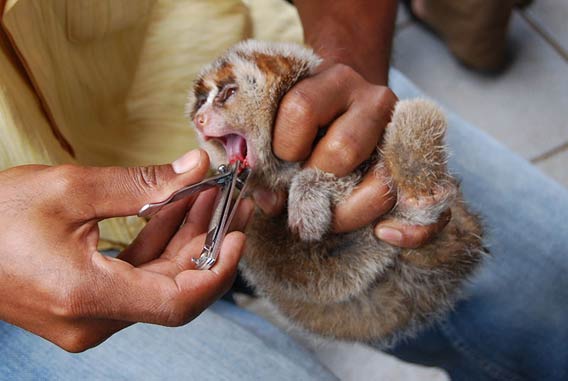Article based on a 2009 interview.

Slow lorises like this Sunda Slow Loris juvenile (Nycticebus coucang) have their teeth forcibly removed by animal traffickers in the open-air “bird markets” of Indonesia. The practice is done to either convince buyers that the animal is suitable as a child’s pet or to make people think the animal is an infant.
This photo was taken by Dr. Karmele Llano Sánchez of the International Animal Rescue (IAR).
A new video of a slow loris holding an umbrella in a pet store has been viewed nearly a million and a half times, yet such viral videos may imperil these ‘cute’ and endangered primates by encouraging an illegal and often cruel pet trade.
“Most people who see them in this setting want one, too!” says Angelina Navarro-Montes, a graduate student at Oxford Brookes University who has conducted studies of the slow-loris Internet trade, told mongabay.com in 2009. “There is also a big misconception on [YouTube] and a lot of viewers think it’s perfectly legal to have them as pets.”
However, owning a slow loris as a pet is illegal in all of the five species range countries.
The desire to keep a slow loris as a pet is obvious: they are exceptionally adorable, sporting huge eyes and a curious demeanor. Dr. Anna Nekaris, an anthropologist who specializes in slow-loris research at Oxford Brookes University told mongabay.com in 2009 that people are also drawn to them because “they are docile to hold.” However, she adds that the loris willingness to be held is not because they are comfortable but rather “it is part of their defense mechanism—to be still and silent” when they feel threatened.
Given their nature, slow lorises are easily caught, making them readily available to the black market pet trade. Slow- loris parents “park their infants alone throughout the night. The infants are particularly defenseless and easy to catch; any hunter going into the forest will just grab a loris if he sees it,” Nekaris explains.
If hunters find a slow loris parent with a baby, they often kill the parent.
Infants are then transported in sacks, sometimes several in one sack with their arms tied, or in wire cages, which cut their skin.
Usually, poachers remove the slow loris’ teeth to make the loris a more pleasant “pet”. The teeth are taken out using pliers and without any anesthetic. The practice, which Navarro-Montes dubs “evil,” can lead to infection and even death. In addition, losing its teeth makes it difficult for the loris to eat a healthy diet.
Slow lorises “are very susceptible to stress when being moved to a new environment or when put in an inappropriate display,” Nekaris says. Due to this sensitivity to stress, it is estimated 30-90 percent of captured slow lorises don’t survive being transported by poachers and made “people-friendly” before being sold as pets.
Even if the slow loris survives long enough to be sold as a pet, it remains a wild animal, not adapted for living with humans. Most of the YouTube videos show slow lorises moving about in bright daylight, yet these are strictly nocturnal animals. Orphaned infant slow lorises also are unable to clean themselves of feces and urine, because their parents would have cleaned them with their tongues and claws.
In addition, pet slow lorises are often undernourished.
“We are only beginning to learn about their diet in the wild,” Nekaris says, “and most captive lorises are fed an inappropriate diet which leads to tooth decay, diabetes, obesity, kidney failure, and death.”
Comments accompanying the slow-loris videos on YouTube are often full of misinformation. Nekaris points out that one of the biggest falsehoods spread on YouTube is that the slow lorises are not caught in the wild but have been bred in a facility.
“Even the best breeding facilities have great difficulty breeding lorises, and those that do often have difficulty keeping them alive,” she says. “It is so easy to get access to wild-caught lorises, it is highly doubtful that a seller who claims to have captive-bred ones is telling the truth.”
Along with deforestation, the pet trade is pushing slow loris populations to the edge. When offspring are stolen from the forest the viable populations of slow loris in the wild become increasingly threatened. Of the five species of slow loris, four are listed by the IUCN Red List as Vulnerable to extinction, while one, the Javan slow loris, is listed as Endangered.
According to Nekaris and Navarro-Montes, the pet trade for slow lorises is largest in Asia, mostly Japan and China.
“Japan is a massive player and most hosts on YouTube with a pet slow loris are based there,” Navarro-Montes says. Slow lorises sell in Japan for $1,500 to $4,500.
Related articles
Cuddly primate trade banned
(06/11/2007) CITES delegates agreed to a total ban on trade in the slow loris, a Southeast Asian primate commonly trafficked for the pet trade. Environmental groups welcomed the move.
Cuddly slow loris threatened by the pet trade
(05/09/2007) The slow loris, a big-eyed primate found in the rainforests of southeast Asia, is threatened by the international pet trade said ProFauna Indonesia, a wildlife activist group that has called for a ban on the illegal trafficking of the charismatic animal.